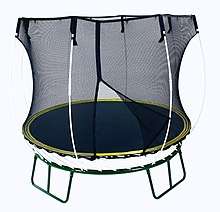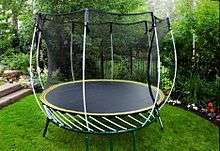Springfree Trampoline
Springfree Trampoline is a global company that manufactures recreational trampoline products and accessories. The unique Springfree design was invented by Dr. Keith Vivian Alexander, an associate professor in the Mechanical Engineering Department at the University of Canterbury in Christchurch, New Zealand.[1]
History

After careful analysis of worldwide trampoline data in 1992 this initiated Dr Keith Vivian Alexander of Canterbury University, Christchurch, New Zealand he revealed that there were 3 major impact zones to a traditional trampoline designed by George Nissen in the 1930s; these impact zones would need to be engineered out in order to build the safest trampoline:
- The Springs - on the jumping surface
- The Steel Frame - on the jumping surface/ jumpers may fall and injure themselves
- The Ground or obstructions on the ground - jumpers would hit as a result of falling off
In 1999, he released his first prototype utilizing glass-reinforced plastic rods, with the first commercial versions began selling in late 2004. In 2009, the Springfree Trampoline won an Australian Design Award.[2]
Design

The most obvious difference between a Springfree Trampoline and the traditional trampoline design is the use of glass-reinforced plastic rods instead of steel coil springs. The US Consumer Product Safety Commission estimates that in 2001 there were 91,870 hospital emergency room-treated injuries associated with trampolines.[3]
The Springfree trampoline uses rods to form a flexible soft edge resulting in the rigid frame being lowered around 450mm below the jumping surface. This removes two known hazards from the jumping surface - the rigid perimeter frame and the steel coil springs.[4][5] The base of the trampoline is also more rigid than conventional trampolines.[6]
Associate Professor David Eager prepared a paper on ensuring compliance with Trampoline Safety Standards; he concluded that only one trampoline sold into the Australia market complies with the intent to Trampoline Safety Standards which is Springfree Trampoline.[7][8]
Injury statistics
Virginia Judge, Fair Trading Minister has ordered a review of the safety of backyard trampolines due to the concerns raised by child safety experts. They have concluded that around 15% of children are admitted to hospital following trampoline injuries; most of the injuries are from falling off the trampoline and 29% are from children falling into/onto the steel frame and springs of the trampoline [9]
A paper has been written on the effectiveness of Pads and Enclosure Nets as safety interventions on consumer trampolines. In 1998 the American Association of Pediatricians wanted to ban consumer trampolines because of the rising injury rate; the International Trampoline Industry Association (ITA) have endeavored to deliver safer trampolines, the ITA and American Society of Testing an Materials (ASTM) agreed on upgrading Trampoline Safety Standards. These improvements appeared in 1999 which included extended padding to cover the springs and the steel frame, warnings and no access to children under 6 and in 2001 enclosure nets were brought in to prevent falling off. See Figure 1 below it is questioned whether these interventions really work [10]
References
- ↑ Associate Professor Keith Alexander - University of Canterbury
- ↑ http://www.designawards.com.au/application_detail.jsp?status=8&applicationID=4392&year=2009
- ↑ "Archived copy". Archived from the original on 2013-02-03. Retrieved 2013-02-01.
- ↑ Keith Alexander, David Eager, Carl Scarrott, et al. "Effectiveness of pads and enclosures as safety interventions on consumer trampolines", British Medical Journal, November 29, 2009.
- ↑ "Consumer Product Safety Alert - Trampoline Safety Alert Archived 2013-02-03 at WebCite
- ↑ "What is the Best Trampoline – And Safest – for your Children in 2015?". Trampolines Today. Retrieved 3 January 2016.
- ↑ "Springfree Trampoline". The Safest Trampoline In The World - Trampoline Guide.
- ↑
- ↑
- ↑